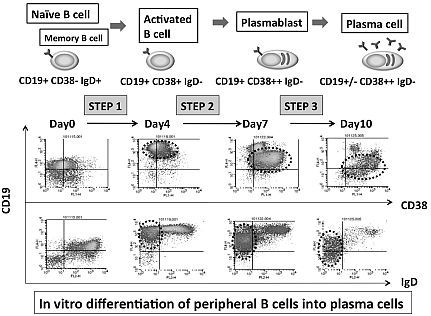In Vitro Differentiation of Naïve/Memory B Cells into Plasma Cells: Difference in Mode of Drug Action between Mycophenolic Acid and Everolimus
Department of Transplant Immunology, Nagoya University School of Medicine, Nagoya, Japan
Nagoya Daini Red Cross Hospital, Nagoya, Japan
Aichi Medical University, Nagoya, Japan
Meeting: 2013 American Transplant Congress
Abstract number: D1473
INTRODUCTION
Recently, attention has been directed towards B cell immunity. However, B cell culture system has not been well established unlike T cell. We attempted to develop in vitro B cell proliferation and differentiation assay and to analyze B cell sensitivity to cyclosporine (CSA), mycophenolic acid (MPA), everolimus (EVR) and prednisolone (PRD).
METHODS
CD19+ peripheral blood mononuclear cells were cultured for 10 days using a 3-step method including CD40L, CpGODN, IL-2, 10 and 15 in STEP 1 (days 0-4), IL-2, 6, 10 and 15 in STEP 2 (days 4-7) and IFN-Α, IL-6 and 15 in STEP 3 (days 7-10). NaÏve and memory B cells (CD19+ CD38- IgD+) were differentiated into activated B cells (CD19+ CD38+ IgD-) in STEP 1 (day 4), plasmablasts (CD19+ CD38++ IgD-) in STEP 2 (day 7) and plasma cells (CD19low, CD38++, IgD-, CD138+) in STEP 3 (day 10) (Figure 1), resulting in the production of IgG. Inhibitory effects on B cell differentiation and IgG production were examined (n=5).

RESULTS
IgG production on day 10 was significantly suppressed by MPA, EVR and PRD, but not by CSA. Mean percent inhibition values in each step are shown in Table.
| Control | CSA (100)/(400) | MPA (100)/(400) | EVR (1.25)/(5) | PRD (10)/(100) | |
| IgG production (STEP123) | 100 | 100/95.2 | 44.2*/4.8** | 38.5*/13.4** | 44.8/18.6** |
| Activated B cells (STEP 1) | 100 | NT | 111.7/43.6* | 96.8/54.3* | 100.4/103.8 |
| Plasmablasts (STEP 2) | 100 | NT | 95.6/102.2 | 69.8*/63.8* | 94.1/87.8 |
| Plasma cells (STEP 3) | 100 | NT | 97.3/96.3 | 78.7/86.5 | 71.5/60.7* |
MPA, EVR and PRD significantly suppressed B cell differentiation in STEP 1, in STEP 1/2, and in STEP 3, respectively. IgG production was still effectively suppressed by EVR addition even after STEP 2, and by PRD even after STEP 3.
CONCLUSIONS
MPA and EVR efficiently suppressed cell proliferation during the early phase of B cell immune reaction. EVR could act in a later phase than MPA. In light of drug action sites, immunosuppressive agents can be selected.
To cite this abstract in AMA style:
Haneda M, Owaki M, Iwasaki K, Miwa Y, Watarai Y, Uchida K, Kobayashi T. In Vitro Differentiation of Naïve/Memory B Cells into Plasma Cells: Difference in Mode of Drug Action between Mycophenolic Acid and Everolimus [abstract]. Am J Transplant. 2013; 13 (suppl 5). https://atcmeetingabstracts.com/abstract/in-vitro-differentiation-of-navememory-b-cells-into-plasma-cells-difference-in-mode-of-drug-action-between-mycophenolic-acid-and-everolimus/. Accessed December 22, 2025.« Back to 2013 American Transplant Congress
